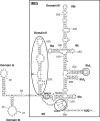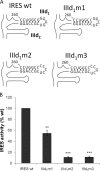Modulation of translation initiation efficiency in classical swine fever virus
- PMID: 22674994
- PMCID: PMC3421749
- DOI: 10.1128/JVI.00346-12
Modulation of translation initiation efficiency in classical swine fever virus
Abstract
Modulation of translation initiation efficiency on classical swine fever virus (CSFV) RNA can be achieved by targeted mutations within the internal ribosome entry site (IRES). In this study, cDNAs corresponding to the wild-type (wt) or mutant forms of the IRES of CSFV strain Paderborn were amplified and inserted into dicistronic reporter plasmids encoding Fluc and Rluc under the control of a T7 promoter. The mutations were within domains II, IIId(1), and IIIf of the IRES. The plasmids were transfected into baby hamster kidney (BHK) cells infected with recombinant vaccinia virus vTF7-3, which expresses the T7 RNA polymerase. IRES mutants with different levels of IRES activity were identified and then introduced by homologous recombination into bacterial artificial chromosomes (BACs) containing CSFV Paderborn cDNA downstream of a T7 promoter. From the wt and mutant BACs, full-length CSFV RNA transcripts were produced in vitro and electroporated into porcine PK15 cells. Rescued mutant viruses were obtained from RNAs that contained mutations within domain IIIf which retained more than 75% of the wt translation efficiency. Sequencing of cDNA generated from these rescued viruses verified the maintenance of the introduced changes within the IRES. The growth characteristics of each rescued mutant virus were compared to those of the wt virus. It was shown that viable mutant viruses with reduced translation initiation efficiency can be designed and generated and that viruses containing mutations within domain IIIf of the IRES have reduced growth in cell culture compared to the wt virus.
Figures







References
-
- Belsham GJ. 2009. Divergent picornavirus IRES elements. Virus Res. 139:183–192 doi:10.1016/j.virusres.2008.07.001 - DOI - PubMed
-
- Belsham GJ, Nielsen I, Normann P, Royall E, Roberts LO. 2008. Monocistronic mRNAs containing defective hepatitis C virus-like picornavirus internal ribosome entry site elements in their 5′ untranslated regions are efficiently translated in cells by a cap-dependent mechanism. RNA 14:1671–1680 doi:10.1261/rna.1039708 - DOI - PMC - PubMed
-
- Berry KE, Waghray S, Doudna JA. 2010. The HCV IRES pseudoknot positions the initiation codon on the 40S ribosomal subunit. RNA 16:1559–1569 doi:10.1261/rna.2197210 - DOI - PMC - PubMed
-
- Berry KE, Waghray S, Mortimer SA, Bai Y, Doudna JA. 2011. Crystal structure of the HCV IRES central domain reveals strategy for start-codon positioning. Structure 19:1456–1466 doi:10.1016/j.str.2011.08.002 - DOI - PMC - PubMed
Publication types
MeSH terms
Substances
LinkOut - more resources
Full Text Sources

